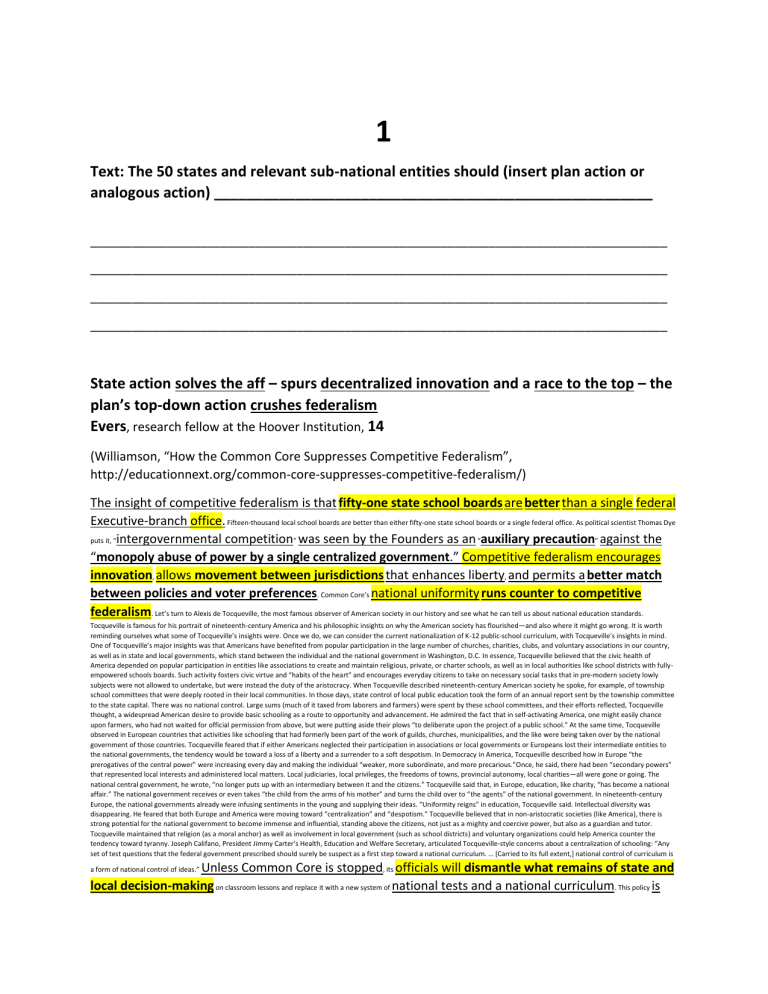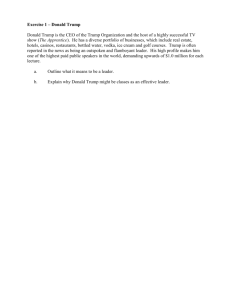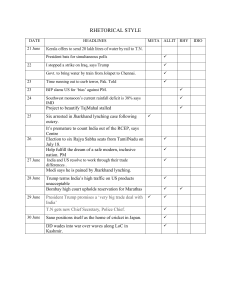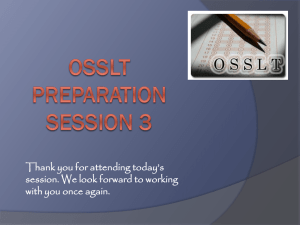
1 Text: The 50 states and relevant sub-national entities should (insert plan action or analogous action) ______________________________________________________ ____________________________________________________________________________________ ____________________________________________________________________________________ ____________________________________________________________________________________ ____________________________________________________________________________________ State action solves the aff – spurs decentralized innovation and a race to the top – the plan’s top-down action crushes federalism Evers, research fellow at the Hoover Institution, 14 (Williamson, “How the Common Core Suppresses Competitive Federalism”, http://educationnext.org/common-core-suppresses-competitive-federalism/) The insight of competitive federalism is that fifty-one state school boards are better than a single federal Executive-branch office. Fifteen-thousand local school boards are better than either fifty-one state school boards or a single federal office. As political scientist Thomas Dye puts it, “intergovernmental competition” was seen by the Founders as an “auxiliary precaution” against the “monopoly abuse of power by a single centralized government.” Competitive federalism encourages innovation, allows movement between jurisdictions that enhances liberty, and permits a better match between policies and voter preferences. Common Core’s national uniformity runs counter to competitive federalism. Let’s turn to Alexis de Tocqueville, the most famous observer of American society in our history and see what he can tell us about national education standards. Tocqueville is famous for his portrait of nineteenth-century America and his philosophic insights on why the American society has flourished—and also where it might go wrong. It is worth reminding ourselves what some of Tocqueville’s insights were. Once we do, we can consider the current nationalization of K-12 public-school curriculum, with Tocqueville’s insights in mind. One of Tocqueville’s major insights was that Americans have benefited from popular participation in the large number of churches, charities, clubs, and voluntary associations in our country, as well as in state and local governments, which stand between the individual and the national government in Washington, D.C. In essence, Tocqueville believed that the civic health of America depended on popular participation in entities like associations to create and maintain religious, private, or charter schools, as well as in local authorities like school districts with fullyempowered schools boards. Such activity fosters civic virtue and “habits of the heart” and encourages everyday citizens to take on necessary social tasks that in pre-modern society lowly subjects were not allowed to undertake, but were instead the duty of the aristocracy. When Tocqueville described nineteenth-century American society he spoke, for example, of township school committees that were deeply rooted in their local communities. In those days, state control of local public education took the form of an annual report sent by the township committee to the state capital. There was no national control. Large sums (much of it taxed from laborers and farmers) were spent by these school committees, and their efforts reflected, Tocqueville thought, a widespread American desire to provide basic schooling as a route to opportunity and advancement. He admired the fact that in self-activating America, one might easily chance upon farmers, who had not waited for official permission from above, but were putting aside their plows “to deliberate upon the project of a public school.” At the same time, Tocqueville observed in European countries that activities like schooling that had formerly been part of the work of guilds, churches, municipalities, and the like were being taken over by the national government of those countries. Tocqueville feared that if either Americans neglected their participation in associations or local governments or Europeans lost their intermediate entities to the national governments, the tendency would be toward a loss of a liberty and a surrender to a soft despotism. In Democracy in America, Tocqueville described how in Europe “the prerogatives of the central power” were increasing every day and making the individual “weaker, more subordinate, and more precarious.”Once, he said, there had been “secondary powers” that represented local interests and administered local matters. Local judiciaries, local privileges, the freedoms of towns, provincial autonomy, local charities—all were gone or going. The national central government, he wrote, “no longer puts up with an intermediary between it and the citizens.” Tocqueville said that, in Europe, education, like charity, “has become a national affair.” The national government receives or even takes “the child from the arms of his mother” and turns the child over to “the agents” of the national government. In nineteenth-century Europe, the national governments already were infusing sentiments in the young and supplying their ideas. “Uniformity reigns” in education, Tocqueville said. Intellectual diversity was disappearing. He feared that both Europe and America were moving toward “centralization” and “despotism.” Tocqueville believed that in non-aristocratic societies (like America), there is strong potential for the national government to become immense and influential, standing above the citizens, not just as a mighty and coercive power, but also as a guardian and tutor. Tocqueville maintained that religion (as a moral anchor) as well as involvement in local government (such as school districts) and voluntary organizations could help America counter the tendency toward tyranny. Joseph Califano, President Jimmy Carter’s Health, Education and Welfare Secretary, articulated Tocqueville-style concerns about a centralization of schooling: “Any set of test questions that the federal government prescribed should surely be suspect as a first step toward a national curriculum. … [Carried to its full extent,] national control of curriculum is Unless Common Core is stopped, its officials will dismantle what remains of state and local decision-making on classroom lessons and replace it with a new system of national tests and a national curriculum. This policy is a form of national control of ideas.” Tocqueville’s nightmare: As in Europe, education “has become a national affair” and Common Core is the vehicle for imposing in America a one-size-fits-all centralization like that administered by the National Ministry of Education in France. Federalism, including horizontal interjurisdictional competition, allows policies better matched to needs and preferences of voters. It allows individuals and families to “vote with their feet”—to move to jurisdictions that they like, where the authorities don’t act counter to their liberties and preferences. Competitive federalism allows experimentation by alternative jurisdictions. One state can try one policy, while another state tries something else. This is why it is called the “laboratory of democracy.” This feature of federalism is what brought Massachusetts, Indiana, California and several other states to have the outstanding curriculumcontent standards that they had before the Common Core. This is the feature of federalism that facilitates an exit strategy from Common Core: It allows states that are leaving Common Core to repeal and replace the national curriculum-content standards with outstanding pre-Common Core state standards. This can be done on an interim basis, while those states design their own replacement standards for the long run. Then the rivalry that takes place under competitive federalism will go back to work to the benefit of teachers, students, and everyone who wants a well-educated citizenry— and also everyone who wants to have the freedoms that are protected by the U.S. Constitution’s Madisonian system of federalism. 2 Trump dedicated to reducing federal influence in education now The Washington Times 2017 (S.A. Miller, Reporter for The Washington Times, “Trump to pull feds out of K-12 education”, April 26th 2017, http://www.washingtontimes.com/news/2017/apr/26/donaldtrump-pull-feds-out-k-12-education/, accessed 6/3/17, JK) President Trump signed an executive order Wednesday to start pulling the federal government out of K12 education, following through on a campaign promise to return school control to state and local officials. “For too long the government has imposed its will on state and local governments. The result has been education that spends more and achieves far, far, far less,” Mr. Trump said. “My administration has been working to reverse this federal power grab and give power back to families, cities [and] states — give power back to localities.” He said that previous administrations had increasingly forced schools to comply with “whims and dictates” from Washington, but his administration would break the trend. The order, dubbed the “Education Federalism Executive Order,” will launch a 300-day review of Obama-era regulations and guidance for school districts and directs Education Secretary Betsy DeVos to modify or repeal measures she deems an overreach by the federal government. “We know local communities know it best and do it best,” said Mr. Trump, who was joined by several Republican governors for the signing. “The time has come to empower teachers and parents to make the decisions that help their students achieve success.” Federal action on education upsets the overall balance of federalism. Lawson 13 – Aaron Lawson, Associate at Edelson PC where his practice focuses on appeals and complex motion practice, J.D. from UMich, Educational Federalism: A New Case for Reduced Federal Involvement in K-12 Education, Brigham Young University Education and Law Journal, Article 5, Volume 2013, Issue 2, Published in the summer of 2013, http://digitalcommons.law.byu.edu/cgi/viewcontent.cgi?article=1333&context=elj Every state constitution, in contrast with the Federal Constitution, contains some guarantee of education.18 State courts split into two groups on how to give effect to these guarantees: (1) by evaluating education policy under Equal Protection by declaring education a fundamental right or by treating wealth as a suspect classification,19 or (2) by evaluating education policies under a framework of educational adequacy.20 In either case, these clauses establish substantive educational guarantees on the state level that do not exist at the federal level and provide the courts with a role in ensuring the fulfillment of these guarantees.21 These clauses also help to create a valuable political dynamic, which has inured to the benefit of children. As part of this political dynamic, courts define the contours of these affirmative guarantees, and the legislature fulfills its own constitutional duty by legislating between those boundaries.2 However, when the federal government legislates or regulates in a given field, it necessarily constrains the ability of states to legislate in that same field.23 In the field of education, the ability of courts to protect the rights of children is dependent on the ability of legislatures freely to react to courts. As such, anything that constrains state legislatures also constrains state courts and upsets this valuable political dynamic created by the interaction of state legislatures and state courts. An expansive federal role in educational policymaking is normatively undesirable when it threatens to interfere with this political dynamic. This dynamic receives scant attention in the literature described above. However, mindfulness of this dynamic is crucial to the proper placement of the educational policymaking and regulatory epicenter. Constraints on state legislatures would not be as problematic if the federal government had proven itself adept at guaranteeing adequate educational opportunity for all students. However, RTTT and NCLB have, in some cases, proven remarkably unhelpful for poor and minority students.24 These negative outcomes, of course, are not guaranteed. However, the fact that federal involvement in education has produced undesirable outcomes for poor and minority students should cause policymakers to reexamine whether it is most desirable for the federal government to play such a significant role in education. This Comment argues that it is not. Federalism maintains sanctuary cities, scaling back mass deportation Somin 11/26/16 https://www.washingtonpost.com/news/volokh-conspiracy/wp/2016/11/26/federalism-the-constitution-andsanctuary-cities/?utm_term=.d2d1595c1ecb Ilya Somin is Professor of Law at George Mason University. His research focuses on constitutional law, property law, and popular political participation. He is the author of "The Grasping Hand: Kelo v. City of New London and the Limits of Eminent Domain" and "Democracy and Political Ignorance: Why Smaller Government is Smarter." The looming fight over sanctuary cities is an example of how federalism and constitutional limitations on federal power can sometimes protect vulnerable minorities – in this case undocumented immigrants. States and localities have a reputation for being enemies of minority rights, while the federal government is seen as their protector. That has often been true historically. But sometimes the situation is reversed – a pattern that has become more common in recent years. Many deportation advocates claim it is essential to enforce the law against all violators. But the vast majority of Americans have violated the law at some point in their lives, and few truly believe that all lawbreaking should be punished, regardless of the nature of the law in question or the reason for the violation. And few have more defensible reasons for violating law than undocumented migrants whose only other option is a lifetime of Third World poverty and oppression. In any event, even if there is an obligation to enforce a particular law, it does not follow that the duty falls on state and local governments. At this point, it is not yet clear how far Trump intends to push his deportation agenda. Election exit polls suggest that mass deportation is not a popular policy, with 70% of the public believing that undocumented migrants working in the US should be offered permanent residency, and only 25% indicating they should be deported. The spectacle of the federal government trying to deport large numbers of people in the face of local resistance is unlikely to make good PR for the Trump administration. Perhaps that will lead them to scale back their ambitions. Should Trump choose to pursue a policy of mass deportation regardless of the potential downsides, sanctuary cities can refuse to cooperate with it. And they will have the Constitution on their side. Deportation massively pumps food prices, causes ag collapse Shanker 3/30/16 Deena Shanker Food and consumer goods reporter http://qz.com/641886/donald-trumps-immigration-policycould-lead-to-higher-food-prices-and-shortages/ A Trump presidency could halt the wheels of agriculture Under a Trump immigration plan, though, things would undoubtedly get much worse. The sudden disappearance of half of America’s hired crop workers would have catastrophic impacts on the $835 billion agriculture sector, of which about $177 billion—or about 1% of the US’s GDP—comes from farms. This would have wide-ranging implications for Americans, both short-term and long-term. Labor shortages would create food shortages, increase imports, and raise prices. “If agriculture were to lose access to all undocumented workers, agricultural output would fall by $30 to $60 billion,” the Farm Bureau predicts. “The immediate loss of this large a share of the general work force would cause economic chaos,” the organization found in a 2014 report on labor. Food industry leaders agree. “Almost certainly there would be a great deal of difficulty making the engine of agriculture work,” says Tony Sarsam, CEO of ReadyPac Foods, a major producer of packaged salads, sliced fruit and pre-cut vegetables. He predicts “problems in the food supply if we started shipping people home.” “It’s a frightening prospect,” said Michael Joseph, CEO of Green Chef, an organic meal kit delivery company. “I don’t think voters are connecting the dots,” he says. “We will have skyrocketing prices, driven by shortages.” The Farm Bureau’s 2014 report estimated that an enforcement-only approach that leaves almost no undocumented workers in the economy, like the one proposed by Trump, would raise food prices 5%-6%. It also predicted “smaller supplies of products generally despite higher imports.” American farms could produce 15%-31% less vegetables, 30%-61% less fruit, and 13%-27% less red meat. Some of the cost would be passed to consumers, but most would be absorbed by farmers. They could outputs, according to the report. face net revenue losses of 30%-40% from the combination of higher costs and lower Ag collapse puts 3 billion lives at risk immediately Lester R. Brown, President of the Earth Policy Institute, 2-7-2005 http://www.peopleandplanet.net/doc.php?id=2424 The world has been slow to respond to these new threats to food security. In four of the last five years the world grain harvest has fallen short Another large world grain shortfall in could drop stocks to the lowest level on record and send world food prices into uncharted territory of rising food prices. IT CONTINUES Many Americans see terrorism as the principal threat to security, but for much of humanity, the effect of water shortages and rising temperatures on food security are far more important issues. For the 3 billion people who live on 2 dollars a day or less and who spend up to 70 per cent of their income on food, even a modest rise in food prices can quickly become life-threatening. For them, it is the next meal that is the overriding concern." of consumption. As a result, world grain stocks are now at their lowest level in 30 years. 2005 Food instability causes extinction Winnail ‘96 - PhD, MPH [Douglas S., “On the Horizon: Famine,” September/October, http://www.kurtsaxon.com/foods004.htm] As a result grain prices are the highest on record. Worldwatch Institute's president, Lester Brown, writes, "No other economic indicator is more politically sensitive that rising food prices.... Food prices spiraling out of control could trigger not only economic instability but widespread political upheavals"-- even wars. The chaotic weather conditions we have been experiencing appear to be related to global warming caused by the release of pollutants into the earth's atmosphere. A recent article entitled "Heading for Apocalypse?" suggests the effects of global warming--and its side effects of increasingly severe droughts, floods and storms--could be catastrophic, especially for agriculture. The unpredictable shifts in temperature and rainfall will pose an increased risk of hunger and famine for many of the world's poor. With world food stores dwindling, grain production leveling off and a string next couple of years will be critical. Agricultural experts suggest it will take two bumper crops in a row to bring supplies back up to normal. However, poor harvests in 1996 and 1997 could create severe food shortages and push millions over the edge. Is it possible we are only one or two harvests away from a global disaster? Is there any significance of bad harvests around the world, the to what is happening today? Where is it all leading? What does the future hold? The clear implication is that things will get worse before they get better. Wars, famine and disease will affect the lives of billions of people! Although famines have occurred at various times in the past, the new famines will happen during a time of unprecedented global stress--times that have no parallel in recorded history--at a time when the total destruction of humanity would be possible! Is it merely a coincidence that we are seeing a growing menace of famine on a global scale at a time when the world is facing the threat of a resurgence of new and old epidemic diseases, and the demands of an exploding population? These are pushing the world's resources to its limits! The world has never before faced such an ominous series of potential global crises at the same time! However, droughts and shrinking grain stores are not the only threats to world food supplies. According to the U.N.'s studies, all 17 major fishing areas in the world have either reached or exceeded their natural limits. In fact, nine of these areas are in serious decline. The realization that we may be facing a shortage of food from both oceanic and land-based sources is a troubling one . It's troubling because seafood--the world's leading source of animal protein--could be depleted quite rapidly. In the early 1970s, the Peruvian anchovy catch--the largest in the world--collapsed from 12 million tons to 2 million in just three years from overfishing. If this happens on a global scale, we will be in deep trouble. This precarious situation is also without historical precedent! 3 The democrats will win back the house in the November midterms elections due to Trump’s incompetence – this will result in checks and possible impeachment. Grenier 1-4 [Eric. “Republicans have tough odds of holding Congress in 2018, and Trump makes them worse” 1/4/18 http://www.cbc.ca/news/politics/grenier-2018-midterms-1.4458814 //GBS-JV] It will not be easy for the Republicans to retain control of both houses of the U.S. Congress in the 2018 midterm elections. The Democrats enjoy a wide lead in the polls, and voters have swung sharply to that party in a series of special elections in 2017. But the biggest problem might be Donald Trump. The party that controls the White House has historically done poorly in the midterms. Compounding the problem for Republicans, however, is that rarely has the occupant of the White House been as unpopular as Trump. The U.S. president's approval rating is averaging about 38 per cent, lower than any president at this stage of his mandate since modern polling began. His party is just as unpopular. Generic congressional ballot polls put the Republicans at about 37 per cent, 13 points behind the Democrats. That is the kind of margin that could flip the House of Representatives. All 435 seats in the House will be contested in November. The Democrats need to steal 25 of those currently occupied by the Republicans to take control. When the Democrats last won the House in the 2006 and 2008 elections — votes are held every two years — they beat the Republicans by eight and 11 percentage points. The polls, as well as significant swings toward the Democrats in a series of special elections, suggest the Democrats are on track for a similar victory. Not only would a Democratic win in the House put up further legislative obstacles for Trump — having the Republicans in control has been problematic enough — but it would open the door to the impeachment of the president. The plan flips the current narrative – it corrects unpopular education policies that will determine elections Klein 18(Alyson, is an assistant editor for Education Week. She covers federal policy and Congress and reports on stimulus programs and ESEA/No Child Left Behind. She is a co-author of the blog Politics K-12, 1/1, "Trump, Congress, and Education in 2018: Eight Big Questions," Education Week - Politics K-12, http://blogs.edweek.org/edweek/campaign-k12/2018/01/donald_trump_education_2018_eight_big_questions.html, MSCOTT) How will education play in the midterms? The party that doesn't hold the White House typically does well in midterm congressional elections, so Democrats have a shot at retaking the House of Representatives. And there's a slim chance they could pick up seats in the Senate. So will Democrats use K-12 issues—especially opposition to DeVos—to get voters to the polls? It's a good bet. The party started invoking DeVos' name in fundraising emails even before she was officially sworn in as secretary. And DeVos is even less popular with educators than Trump. Of course, after the midterms comes the presidential race and, probably, a hotly contested Democratic primary, which could mean plenty of talk about education. Checks on Trump solve extinction, structural violence, and every aff impact Baum 16 – Seth, is executive director of the Global Catastrophic Risk Institute, a nonprofit think tank that Baum co-founded in 2011. Baum’s research focuses on risk, ethics, and policy questions about major threats to human civilization, including nuclear war, global warming, and emerging technologies, December 9th ("What Trump means for global catastrophic risk," Bulletin of the Atomic Scientists, Available online at http://thebulletin.org/what-trump-means-global-catastrophic-risk10266, MSCOTT) In 1987, Donald Trump said he had an aggressive plan for the United States to partner with the Soviet Union on nuclear non-proliferation. He was motivated by, among other things, an encounter with Libyan dictator Muammar Qaddafi’s former pilot, who convinced him that at least some world leaders are too unstable to ever be trusted with nuclear weapons. Now, 30 years later, Trump—following a presidential campaign marked by impulsive, combative behavior—seems poised to become one of those unstable world leaders. Global catastrophic risks are those that threaten the survival of human civilization. Of all the implications a Trump presidency has for global catastrophic risk—and there are many—the prospect of him ordering the launch of the massive US nuclear arsenal is by far the most worrisome. In the United States, the president has sole authority to launch atomic weapons. As Bruce Blair recently argued in Politico, Trump’s tendency toward erratic behavior, combined with a mix of difficult geopolitical challenges ahead, mean the probability of a nuclear launch order will be unusually high. If Trump orders an unwarranted launch, then the only thing that could stop it would be disobedience by launch personnel—though even this might not suffice, since the president could simply replace them. Such disobedience has precedent, most notably in Vasili Arkhipov, the Soviet submarine officer who refused to authorize a nuclear launch during the Cuban Missile Crisis; Stanislav Petrov, the Soviet officer who refused to relay a warning (which turned out to be a false alarm) of incoming US missiles; and James Schlesinger, the US defense secretary under President Richard Nixon, who reportedly told Pentagon aides to check with him first if Nixon began talking about launching nuclear weapons. Both Arkhipov and Petrov are now celebrated as heroes for saving the world. Perhaps Schlesinger should be too, though his story has been questioned. US personnel involved in nuclear weapons operations should take note of these tales and reflect on how they might act in a nuclear crisis. the only way to avoid nuclear war is to try to avoid the sorts of crises that can prompt nuclear launch. China and Russia, which both have large arsenals of long-range nuclear weapons and tense relationships with the United States, are the primary candidates for a nuclear conflagration with Washington. Already, Trump has increased tensions with China by taking a phone call from Taiwanese President Tsai Ingwen. China-Taiwan relations are very fragile, and this sort of disruption could lead to a war that would drag in the United States. Meanwhile, Trump’s presidency could create some interesting opportunities to improve US relations with Russia. The United States has long been too dismissive of Moscow’s very legitimate security concerns regarding NATO expansion, missile defense, and other encroachments. In stark defiance of US political convention, Trump speaks fondly of Russian President Vladimir Putin, an authoritarian leader, and expresses little interest in supporting NATO allies. The authoritarianism is a problem, but Trump’s unconventional friendliness nonetheless offers a valuable opportunity to rethink US-Russia relations for the better. On the other hand, conciliatory overtures toward Russia could backfire. Without US pressure, Russia could become aggressive, perhaps invading the Baltic states. Russia might gamble that NATO wouldn’t fight back, but if it was wrong, such an invasion could lead to nuclear war. Additionally, Trump’s proRussia stance could mean that Putin would no longer be able to use anti-Americanism to shore up domestic support, which could lead to a dangerous political crisis. If Putin fears a loss of power, he could turn to more aggressive military action in hopes of bolstering his support. And if he were to lose power, particularly in a coup, there is no telling what would happen to one of the world’s two largest nuclear arsenals. The best approach for the United States is to rethink Russia-US relations while avoiding the sorts of military and political crises that could escalate to nuclear war. The war at home. Trump has been accused many times of authoritarian tendencies, not least due to his praise for Putin. He also frequently defies democratic norms and institutions, for instance by encouraging violence against opposition protesters during his presidential campaign, and now via his business holdings, which create a real prospect he may violate the Constitution’s rule against accepting foreign bribes. Already, there are signs that Trump is Risks and opportunities abroad. Aside from planning to either persuade or disobey the president, profiting from his newfound political position, for example with an end to project delays on a Trump Tower in Buenos Aires. The US Constitution explicitly forbids the president from receiving foreign gifts, known as “emoluments.” What if, under President Trump, the US government itself becomes authoritarian? Such an outcome might seem unfathomable, and to be sure, achieving authoritarian control would not be as easy for Trump as starting a nuclear war. It would require compliance from a much larger portion of government personnel and the public—compliance government officials are discussing how best to resist illegal and unethical moves from the inside, and citizens are circulating expert advice on how to thwart creeping authoritarianism. But that cannot be taken for granted. Already, the president-elect will take office at a time in which support for democracy may be declining in the United States and other Western countries, as measured by survey data. And polling shows that his supporters were more likely to have authoritarian inclinations than supporters of other Republican or Democratic primary candidates. Moreover, his supporters cheered some of his clearly authoritarian suggestions, like creating a registry for Muslims and implying that through force of his own personality, he would achieve results where normal elected officials fail. An authoritarian US government would be a devastating force. In theory, dictatorships can be benevolent, but throughout history, they have been responsible for some of the largest human tragedies, with tens of millions dying due to their own governments in the Stalinist Soviet Union, Nazi Germany, and Maoist China. Thanks to the miracles of modern technology, an authoritarian United States could wield overwhelming military and intelligence capabilities to even more disastrous effect. Return to an old world order. Trump has suggested he might pull the United States back from the post-World War II international order it helped build and appears to favor a pre-World War II isolationist mercantilism that would have the United States look out for its unenlightened self-interest and nothing more. This would mean retreating from alliances and attempts to promote Such a retreat from globalization would have important implications for catastrophic risk. The post-World War II international system has proved remarkably stable and peaceful. Returning to the pre-World War II system risks putting the world on course for another major war, this time with deadlier weapons. International cooperation is also essential for addressing global issues like climate change, infectious disease outbreaks, arms control, and the safe management of emerging technologies. On the other hand, the globalized economy can be fragile. Shocks in one place can cascade around the world, and a bad democracy abroad, and an embrace of economic protectionism at home. enough shock could collapse the whole system, leaving behind few communities that are able to support themselves. Globalization can also bring dangerous concentrations of wealth and power. complete rejection of globalization would be a dangerous mistake. Playing with climate dangers. Climate change will not wipe out human populations as quickly as a nuclear bomb would, but it is wreaking slow-motion havoc that could ultimately be just as devastating. Trump has been all over the map on the subject, variously supporting action Nevertheless, to reduce emissions and calling global warming a hoax. On December 5th he met with environmental activist and former vice president Al Gore, giving some cause for hope, but later the same week said he would appoint Oklahoma Attorney General Scott Pruitt, who denies the science of climate change, to lead the Environmental Protection Agency. Trump’s energy plan calls for If his energy policy puts more greenhouse gas into the atmosphere—as it may by increasing fossil fuel consumption—it will increase global catastrophic risk. For all global catastrophic risks, it is important to remember that the US president is hardly the only important actor. Trump’s election shifts the landscape of energy independence with development of both fossil fuels and renewables, as well as less environmental regulation. risks and opportunities, but does not change the fact that each of us can help keep humanity safe. His election also offers an important reminder that outlier events sometimes happen. Just because election-winning politicians have been of a particular mold in the past, doesn’t mean the same kind of leaders will continue to win. Likewise, just because we have avoided global catastrophe so far doesn’t mean we will continue to do so. 4 – Insert T Varun Interpretation: Violation: Vote Neg for limits and ground – justifies an infinite number of affs that makes it impossible to prepare for and takes away key generic arguments from the negative Case – Insert Case Varun




